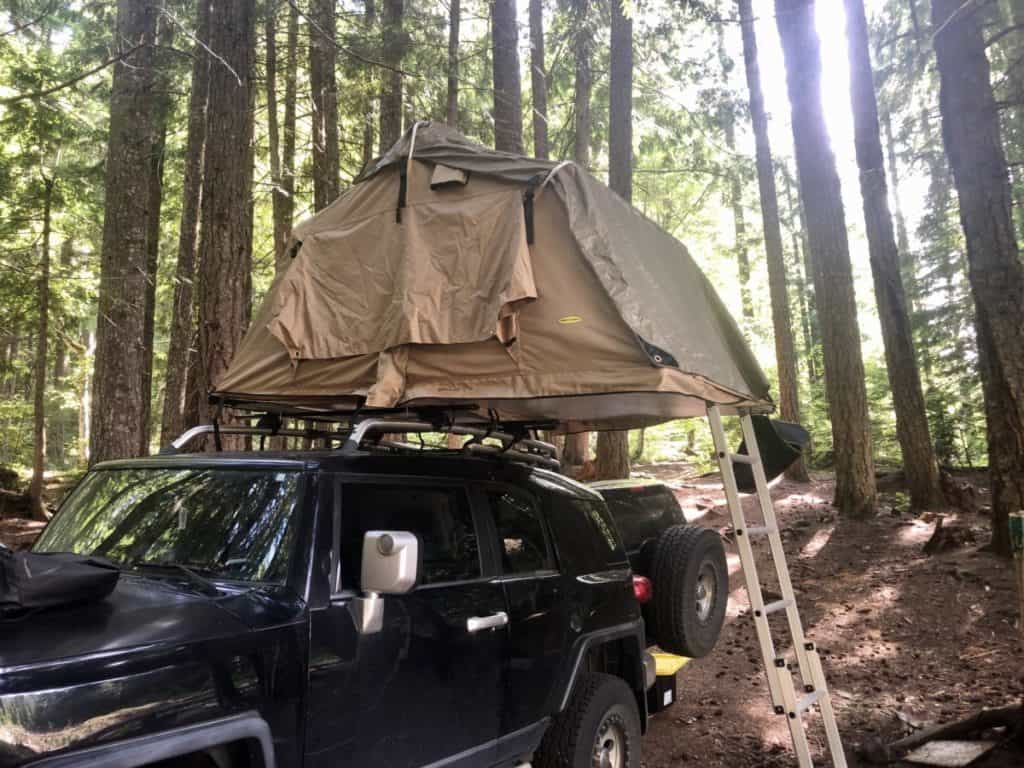
Traditional ground tents are made of a very thin fabric and come with a rainfly in case it happens to rain. On the other hand, roof top tents are constructed of a much thicker fabric and also have a rainfly to boot! Even though the fabric is thicker, does this also mean that roof top tents are waterproof too?
Almost all roof top tents are waterproof since the fabric is made of an impregnated poly-cotton material. On top of that, roof top tents also come with a thick waterproof polyester rainfly.
Since the fabric on a roof top tent (RTT) is designed to be waterproof it should stay like that forever, right? Actually, there are some additional steps and tips you can take to ensure your RTT will stay waterproof for its lifetime.
Tips to waterproof your RTT:
Before we get into all of the tips, here is a quick video version from our Youtube channel if you’re more of a visual learner!
Water RTT before first use
If I hadn’t done hours of endless research reading articles and watching videos about RTTs, I’m not sure I would have come across this hugely important tip! It’s so simple but each RTT owner needs to do this before taking their new toy into the rain.
You need to set up your tent, remove the rainfly, and spray your tent with water. This helps the stitching and fabric of the tent bond tighter together, which in turn, will prevent water from getting in!
I’ve only heard from a few other RTT owners pointing out the need to do this. To my surprise, I found many other campers hadn’t known about this tip either. It’s not like its posted in the manual or instructions!
Another “pro” tip, you should probably take out the mattress before you go ahead and spray the RTT down. I stupidly didn’t do this and had to take the mattress out afterwards while it was soaking wet and then let it air out before I could pack the RTT away. I’ll admit, this wasn’t my finest moment.
This should go without saying, but be sure to let your RTT dry completely before packing it back up. You could easily cause irreversible damage if you don’t do this. Here is a quick article on Why You Should Dry Your RTT!
Fabric Guard
After many uses, the natural waterproof ability of the tent will slowly fade and become less effective.
To restore and enhance the water repellency of your tent, I would highly recommend applying Fabric Guard! This brand is highly popular among other RTT owners as well.
It brings your tents waterproof ability back to life, prevents stains, and can be used on all fabric types. This product in particular is designed for outdoor fabric use too!
Similar to other outdoor items, the waterproof coating simply weakens over time as you use it. I use this since I live in a highly precipitous area of the United States and it hasn’t failed me yet!
Weatherhood
Sometimes a rainfly simply won’t cut it, especially if it is windy and the rain seems to be coming in sideways. This is where you would need a more robust waterproof cover.
I recommend something like the Tepui Weatherhood because it fully covers all of the fabric on the RTT. While it is specifically made to fit a Tepui tent, you can check your tent’s dimensions to see if it would fit on your model.
A cheaper alternative but a similar principle to this tip is to buy a tarp and clamps at your local hardware store. It might not look the prettiest, but it will keep you dry and that’s what matters!
I find in most scenarios a rainfly is sufficient. However, when we camp in stormy weather and wind ensues, we need something a little more protection to keep us dry.
Canopy covered entrance
Keeping the inside of your tent dry is crucial to waterproofing it. If you don’t have an overhanging canopy, opening and closing the door can allow water to get in easily.
If you can add or opt for a RTT with a canopy I would recommend it if you know you will be camping in rainy weather. This canopy will cover your ladder, therefor keeping the entrance dry.
Best waterproof tents
The fabric and style of a RTT are the biggest factors for its ability to be waterproof! Here are some the tents I believe are the best for handling wet conditions and why.
FSR High Country
I think one of the best softshell RTTs that comes right out of the box ready to shed of water is the FSR High Country series.
The thing I love about this specific model is the tri-layer fabric they implement in this tent. It helps shed off rain with ease and also prevents condensation build-up as well.
The High Country also has a huge canopy covering the entrance of the tent. It doesn’t cover the ladder, but some people actually prefer that so they don’t have to duck as they climb up the ladder.
Last but not least this tent comes with an awesome 210D Poly Oxford silver lining rainfly that has a polyurethane coating. The thing that stands out about the rainfly is its thickness. That is represented by the “210D” metric. “D” stands for denier which is the measurement of yarn thickness.
CVT Summit Edition tents and Tepui’s Ruggedized series are both very impressive as well. Each of these lines is meant to handle extreme conditions. That said, it would still be a good idea to take the added precautions to waterproof it!
Hardshell roof top tents
While many softshell RTTs are fully capable of being sufficiently waterproof, hardshells clearly have the advantage here.
Whether the style is clamshell or pop-up design, both have much less fabric exposed. This way, rain will come in contact with a fully waterproof fiberglass or aluminum shell, rather than a polyester-fabric.
Along with being better equipped to repeal water, the overall quality of a hardshell is usually superior to a softshell. You also won’t have to worry about the cover on the RTT used when closed having any holes are letting any water in. When you close a hardshell RTT, it has a much more air right seal!
Rooftop tent waterproof advantages
There are many advantages the RTTs have over a ground tent to being more waterproof. I would argue the fabric is generally thicker on RTTs than ground tents, which is a factor, but there are also a few other major factors that play a role in this.
Being off the ground
The biggest thing with a RTT is you don’t have to worry about camping in a low point and sitting in a puddle if it rains! With ground tents, you do need to be aware of where you’re setting up your camp or else you could end up in a pool of water!
Since RTTs are elevated, you don’t have to worry about tracking in water or mud. Not only do you stay dry but also more clean in my experience! RTTs usually come with a shoe bag that way you don’t track in any mud or sand.
Canopy
A large number of RTTs have canopies that you can prop up using aluminum poles. The canopies help cover your windows and the entrance of your tent.
I would say this is standard for all RTTs and it is definitely a benefit over a traditional ground tent.
Wrapping Up
Roof top tents already have a significant advantage over ground tents in being waterproof. However, by taking three simple steps, you can renew and even improve your RTTs waterproof ability quite easily.
Some solutions are more expensive than others. I would recommend starting out with the basics and moving to more drastic measures if you feel it is necessary.
While most RTTs can handle rain very well, some are better than others. If you find this to constantly be a problem, consider making the move to a four-season or hardshell RTT.
